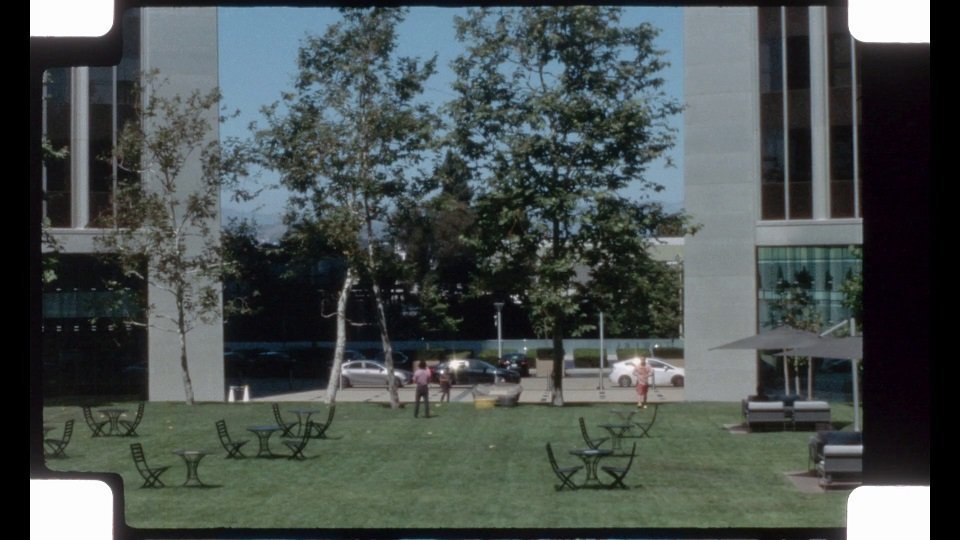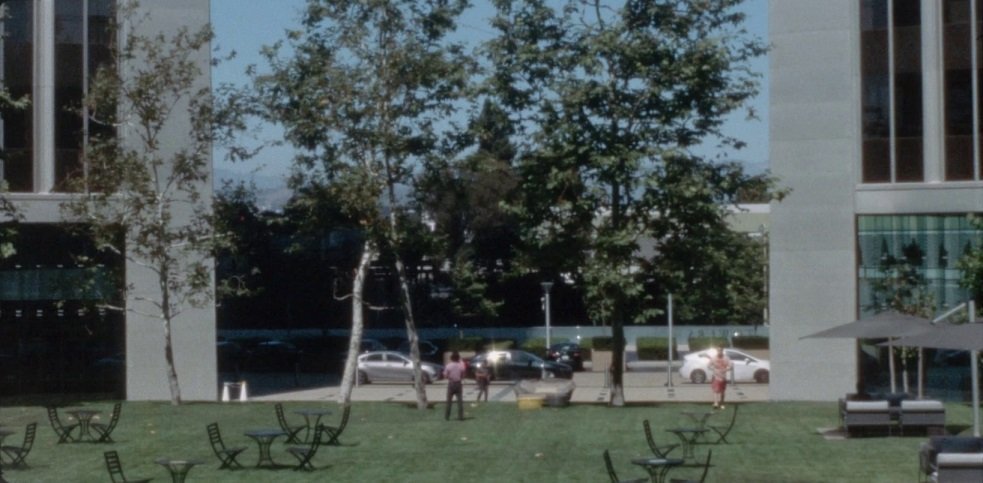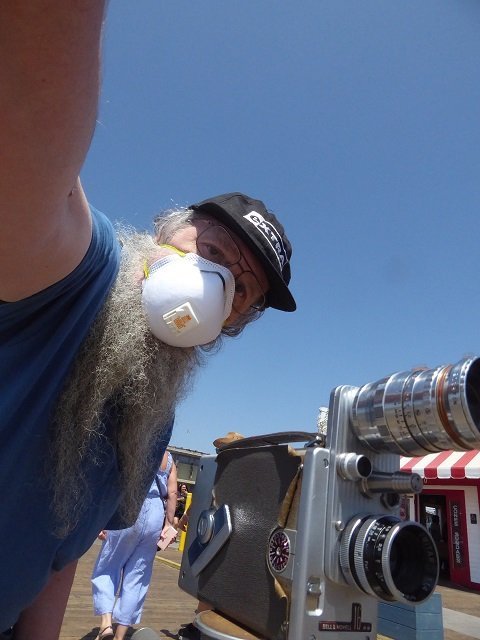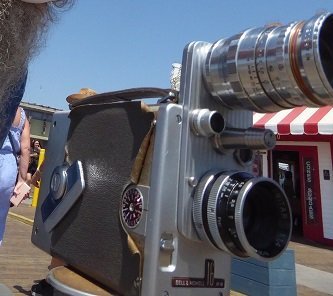
Gary Davis
Basic Member-
Posts
10 -
Joined
-
Last visited
Everything posted by Gary Davis
-
The B&H 200 appears to have an interlock so it won't run if the door is open. Does anyone know anything about this? It may be jammed in one of my cameras (doesn't run) or intermittent in the other (tends to jam until door is opened). thanks! --Gary
-
The Bell & Howell 200 cameras use standard C-mount lenses, HOWEVER, they also require a matching viewfinder lens. I've used a single 25mm viewfinder lens as a guide for a variety of C-mount lenses (12-75mm) and this works to some extent. I've also had some problems with the interlock mechanism of the B&H jamming - I've had better reliability from a Kodak magazine camera that doesn't take C-mount lenses (but that camera has a zoom viewfinder for all lenses 15-152mm). The Kodak (B&H) magazines were designed for double-perf film and others have reported poor results trying to use single-perf film, HOWEVER, the Kodak camera appears to give a full, clean image between the sprocket holes on the left, making a 2:1 aspect ratio crop possible. The Film Photography Project (April 2024) sells 16mm mags in 7 different stocks, and a mag costs $80-$100 including processing and scanning by FPP. This is great news for people who want to use these cameras, but, FPP's processing service is unbearably slow... about six weeks... and the quality is not great. The B&W reversal, in particular, was mottled and quite dirty. However, some people feel this adds to the vintage look! Here's a look at my first two mags from FPP - B&W reversal and Ektachrome. My 2:1 attempt will be developed sometime mid-May. --Gary
-
Interesting! I understand that the late Queen also enjoyed the format... and I'll bet it didn't take her 6 weeks to get her film processed!
-
So your point is - the lab FPP is using for B&W reversal film is worse than any lab ever?
-
I got the Ektrachrome back in the mail on Monday, a mere 46 days after I mailed it in (and so quickly, only because the Post Office did an uncharacteristically fast job on "Ground Advantage"). I'll offer both the raw version with the sprocket area, and a nice 68 second edit below. I've left in the first take of the "title" only to show the lab dirt. I agree that it's great to skip the first and last few feet of the roll, but that's a lot easier to do on a 400' roll which has extra feet, than a 50' roll which doesn't! Anyway, Michael at FPP said to just run off a few frames at the head of the roll, and it's really difficult to tell when the magazine is over. The 16mm magazine has the footage counter built-into the magazine, which is sortof a cool idea, except I found it nearly impossible to read even with a magnifying glass and a flashlight! (And of course, I don't like the idea of shining a light directly on my film to read the counter... although this seems to be harmless). And because the film is inside a metal magazine inside a metal camera, it doesn't make much of a sound when it rolls-out. But I am generally happy with the results! --Gary The full roll and sprockets: A nice 68-second edit:
-
Just hours after I hit "send" on the above message, and precisely 6 weeks after I shot it, I received my Ektrachrome mag back from FPP. I'm pleased to say the developing was MUCH BETTER, and I'm very happy with how the film turned out! I had this roll scanned at 24 FPS and honestly it moves too fast, whatever speed the camera was actually running at, so I'm going to slow it down and edit it before I share it here... just two stills for now. An interesting factor of the Kodak Cine Royal Magazine (16mm) camera is that it fully-exposes the area between the left sprocket holes, making an "Ultra-16"-type project possible. As you can see below, you can actually get a native aspect ratio of 2:1 !! The problem is, the picture is not particularly sharp (it looks better in motion), and it would be difficult to "frame" your images, although with the zoom viewfinder on the Kodak, it might be possible. You can make a very wide, somewhat blurry movie on a very cheap camera with very expensive film! However, since this movie is actually about tall buildings, I won't be doing that here. Now, I said the processing was almost perfect, but as with my B&W roll, the film was dirtier at the beginning and end of the roll, than in the middle. If this is soft dirt, it may not matter as I plan to get the film properly cleaned and rescanned at FILM-TECH. And as it happens, I'm not using my first or last take anyway so it works out okay. BUT, I was wondering how long the usable length of the film really is: a 100' daylight spool has about 105' usable feet if you unload it in the dark. The magazine loses about 1 1/2 feet through its internal threading, but you'd expect FPP to give you extra film to account for that. They don't. The TOTAL length of my processed film (based on time) was 48 1/2 feet. The beginning and end weren't ruined, by any means, just a bit dirty; while the center of the roll was, thankfully, spotless! About 5 feet at the beginning of the roll and 2 feet at the end had some dirt. So in all, I got at least 41 feet of clean film - 1 minute 8 seconds at 24 fps! Did I mention - not a scratch at all! So they question of how/why my B&W project became so scratched, remains a mystery. (it was a different camera, probably a different magazine and possibly a different lab). Finally I'll say: the exposure on ISO 100 Ektrachrome at F/22, 24 FPS on a sunny day, was absolutely perfect (which is why I shot this film at 24 FPS instead of 16 FPS like I used for the ISO 40 B&W). So I really would NOT recommend shooting Ektrachrome at F/16 or 16 FPS, unless you have a cloudy day or an ND filter! --Gary
-
Links to my processed film at the end of this message! I did finally get my 16mm magazine B&W reversal film back from The Film Photography Project (FPP), and if you'd like your film to look like it was developed 100 years ago, FPP can do that! But if you're hoping for modern processing, or to get your film back in less time than it takes to sail from New York to England... and back... three times!... you may be out of luck. Despite my reservations, since I had already purchased another 16mm magazine camera, I shot a second FPP mag - this time loaded with Ektrachrome. I was hoping to get the second roll back before reviewing FPP, but it's been well over five weeks since they received my film, and no word yet - except for an email that they had "checked-in" my film, a full week after they received it. FPP says they are "passionate" about film, and I believe them! But, their passion has not led to a professional business model. How can it take a week to log incoming mail? How can it take 4-6-8 weeks to process and scan film? AND HOW CAN THEY DO SUCH A HORRIBLE JOB OF PROCESSING? It appears that in the past, FPP did "home processing" of customer's movie film, but more recently they updated their website to say that they send your film to "a trusted commercial lab" for processing. I asked Michael at FPP if he could tell me which lab processed my B&W reversal film, so I could bring up my issues with them, but he refused, saying that was confidential information. He also couldn't say if my film had been developed in a standard "continuous processing machine" or some other way. Four problems with the results: the film is badly scratched, it's filthy, there's a "mottled look" or uneven development of the light/clear areas (Michael referred to this as "bleach staining"), and finally, the end of the roll is spotted as well as covered with dust and filth. As to the scratching, Michael points out this could be the magazine or the camera (I'll add: or their double-perfing procedure). Here's the interesting part: to the best I can tell, the magazine camera never actually touches the film (except the sprocket hole) - the focal point is inside the magazine. FPP claims ownership of the magazines, so any way you look at it, FPP scratched the film. And the scratches that start at the beginning of the roll, seem to get worse as the roll progresses. I was expecting the film to be scratched, based on other samples of magazine film I've seen, and I was expecting the transfer to be "a bit dirty" because FPP never claimed to have an ultrasonic cleaner, but I wasn't prepared for HOW dirty the transfer would be, or for the uneven (mottled) development. It's true that in the 1920s, movies seemed to have uneven development in the midtones and dark areas - I don't recall this in the light areas like I'm seeing in film FPP processed in 2023. But I'm certain the industry fixed this problem by the 1930s, because Technicolor wouldn't have worked, if the three negatives all had different densities flickering around the picture. I can't really explain the "spots" towards the end of the roll either - they don't specifically look like water spots - maybe dirt on rollers? As I mentioned, Michael from FPP blamed this on "reversal" film. As it happens, I have some 16mm B&W reversal film that I shot in High School in 1972, and scanned to HD around 2010. I've included a link to a sample of that film for comparison. There is simply NO mottling of the clear areas, the film isn't nearly as dirty, and surprisingly, there's not a single scratch on a film which was edited on a viewer and projected at least 15 times. (Manual-threading projector). In 1972, I was shooting "surplus" film and sending it to the cheapest mail-order lab. That didn't take more than a week or two and clearly the results were fantastically better. The FPP film looks like it was processed in a gravel pit and dried in a laundromat. I don't know what caused the uneven highlights, but I do have a theory. Kodak recently announced a new developer and bleach for B&W reversal processing - the bleach presumably less dangerous, and the developer enhanced to work with the new bleach. Perhaps the lab (or kitchen or wherever FPP developed my film) used the new bleach but not the new developer. This is just a guess - perhaps they just used chemicals which were too old. AND DESPITE ALL THIS, I sent more money to FPP for another mag of film. And when I sent it back, I asked if they'd please send it to the "good" lab for processing ? FPP has recently switched to Internet delivery of small 1080p files (at my suggestion!), and based on the paperwork they sent with the Ektachrome magazine, I was hoping to see my color movie in only 3-4 weeks. Alas, even Michael said that was impossible, and as the weeks tick by, I can only say: shooting real 16mm movies with a $15 camera is a tantalizing project, but waiting for FPP is excruciating. And yes, I did considering opening the magazine, putting the exposed Ektrachrome in a can and sending it to Spectra Film for processing - and even sending the magazine back to FPP as a courtesy (and perhaps they'd refund the processing/scanning fee, although I wouldn't count on it). BUT, the purpose of this experiment was to test FPP's "closed loop" (and current monopoly) on 16mm magazine film, so I felt I had to give them another chance to see if their results with Ektrachrome might be better than the B&W reversal. I'll provide an update when I finally get it back. A few more notes about the film links below. After shooting about 100 "single frames" with the B&H 200T, the camera began to jam. I quickly learned I could "clear the jam" by popping open and closing the rear door where the magazine slides in, but the jams became more frequent. Curiously, the camera always jammed with the shutter closed, so there are no "flash frames" - but this jamming accounts for the "jump cuts" in the first half of the film. After shooting the first two scenes (people on the Santa Monica Pier, and people getting off the train), I tried removing and re-inserting the magazine, and this fixed the jamming problem! But something else curious happened. If you look at the sprocket area on the left, you'll see a "shadow" between the holes which appears rock-steady before I re-seated the magazine. But this area is a bit jumpy after I fixed the jamming! Also you can see a bit of "pull-down jitter" in the highlights of the subsequent train scene. I don't find either of these problems objectionable (for a 60 year old, $25 camera) but it would have been interesting to see the results if the jamming hadn't started. In retrospect, shooting hundreds of single frames may not have been the easiest load for an old camera. A final note: I shot the B&W film at 16 FPS and decided to accept FPP's 16 FPS scanning - despite my concern if 16 fps was a valid rate for digital movies. But, FPP didn't really scan the film at 16 FPS - they scanned it at 24 FPS, and printed every-other frame twice. This is similar to the "3-2 pulldown" used to transfer 24 fps film to 30 fps video, but for several reasons, it's more disruptive. In my opinion, the "jerky motion" this produced is slightly noticeable in playback, but just slightly, and since I was looking for a "different" look to the motion in shooting at 16 FPS, I don't find it objectionable in my film. Especially not compared to the scratches, filth, spots, and mottling! ---Gary First is the raw footage including sprocket areas (2 minutes), then a nice 52-second edit. The final link shows my 1972 B&W reversal film for comparison. comparison B&W reversal film from 1972:
-
I took the bait and shot a movie on a B&H 200T which I purchased for $25 on eBay! I used C-Mount lenses I already had for my Bolex, and fortunately, I had exactly ONE finder lens, from another 200T I purchased that didn't run. I am thrilled that FPP made these cameras useful again, but their service is impossibly slow: 4-6 weeks plus shipping time. (It also took about 10 days to get the film). The camera jammed A LOT which I was able to clear by quickly popping-open and re-closing the door. Before my second day of shooting, I removed and reinserted the magazine and it worked a lot better. What, if anything, will I get on the film? Still waiting for the movie I shot in June!* FPP says the film is developed, awaiting scanning, but they won't email you scans - return by mail only. I already bought ANOTHER mag camera that seems to run - Kodak Cine-Royal 16 for $15.50, including a 25mm lens! I haven't decided if I want to spend another $100-$120 on film. This lens stops-down to F/22, which makes shooting Ektracrhome practical - I think people would have a real problem shooting ISO 100 color reversal on a sunny day in a cine camera at F/16! For my 200T project, I decided to shoot B&W reversal ISO 50, at 16 fps. I've never shot at 16 fps for 16 fps playback, and I'll be interested in "the look." Of course you get more running time, almost 2 minutes from a mag. The B&W reversal film was $20 cheaper than most other stocks, and it's projectable! For one-roll projects, magazine film is actually cheaper than 100' rolls, simply because there's only half as much film. (I asked FPP if they'd accept a 50' roll from my Bolex and they said "no"). As to the "magazine deposit," in the U.S. that's simply paying for the processing and scanning in advance, although it's possible they have different rules for other countries. Again, I'm THRILLED at the idea you can make a 16mm movie for $150 total: camera, lens, film, develop, scan, and shipping four ways! (add $20 for color). The snail-speed and uncertainty of the process are the drawbacks, And the cameras are literally the size of a cellphone! At least in two dimensions... ? --Gary *in fairness to FPP, I shipped the film "Priority" on June 29, so they're still well within their 4-6 week estimate.
-
Hello All! I have a CP-16A which I thought was in usable condition, but I've just realized the film door is stuck closed. The latch turns fine, but I wasn't able to open the door! I've seen another CP-16 with white metal corrosion. The painted metal on my good CP-16 looks fine but the bare metal inside might not be. Suggestions? Also, can anyone suggest an inexpensive solution for battery charging? The camera had a charged battery, but that was a few years ago... thanks! --Gary
-
Hello, I've been shooting film since the early 1960s but this is my first time on this forum! I'm shooting a new movie at 16fps (16mm magazine camera) but it doesn't seem that 16fps is a standard rate for digital video. I was thinking that scanning the film at 30 fps and playing each frame twice might be a good solution! comments? thanks! (picture of my "new" rig below!) --Gary Davis







